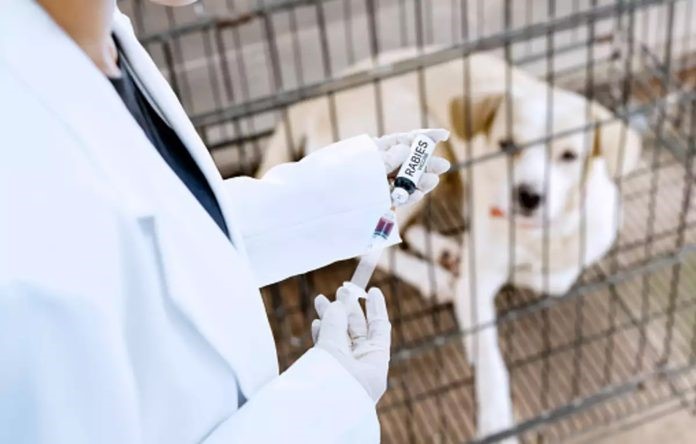RABIES

Source: DailyExcelsior
Disclaimer: Copyright infringement not intended.
Context
- In a significant public health development, the government of Jammu and Kashmir has declared human rabies a notifiable disease under the Epidemic Diseases Act of 1897.
- This decision mandates the immediate reporting of all suspected, probable, and confirmed cases of human rabies by both government and private health facilities, including medical colleges, to the respective Chief Medical Officer and the State Nodal Officer of the National Rabies Control Program (NRCP).
Details
Key Points
- Disease Background:
- Rabies is an acute viral infection affecting all warm-blooded animals, including humans. It is primarily transmitted through animal bites and has an extremely high fatality rate.
- Global and National Context:India accounts for 59.9% of rabies deaths in Asia and 35% of global rabies deaths. However, rabies is entirely preventable with timely and appropriate Post-Exposure Prophylaxis (PEP).
- Importance of Notification:
- Surveillance and Reporting:Establishing a robust surveillance and disease reporting system is crucial to determine the exact magnitude of rabies.
- WHO Goal:The notification aligns with the World Health Organization's goal of zero deaths due to human rabies by 2023.
- Mandate for Reporting:
- Health Facilities' Obligation:All government and private health facilities, including medical colleges, are required to report any suspected, probable, and confirmed cases of human rabies.
- Reporting Format:Cases must be reported using the prescribed formats appended as Annexure-1 and Annexure-2 to the notification.
- Legal Framework:
- Epidemic Diseases Act of 1897:The notification exercises powers conferred by Section 2 of this Act, officially declaring human rabies a notifiable disease in Jammu and Kashmir.
Implications
Public Health Impact:
- Improved Control Measures:Enhanced surveillance will facilitate better contact tracing and prompt prophylactic measures, reducing the risk of infection among individuals exposed to the same source.
- Data-Driven Strategies:Accurate reporting will provide essential data for crafting targeted rabies control and prevention strategies.
Healthcare System Integration:
- Mandatory Reporting:Integrating rabies reporting into the routine functions of all healthcare facilities ensures comprehensive data collection and timely intervention.
- Collaboration:The notification fosters collaboration between government and private health sectors, ensuring a unified approach to rabies management.
Long-Term Goals:
- Eradication Efforts:The declaration is a step towards achieving long-term goals of rabies eradication, reducing the burden of the disease in the region.
- Global Alignment:Jammu and Kashmir's initiative aligns with global public health goals, contributing to the broader effort to eliminate rabies worldwide.
About Rabies
- Rabies is a deadly viral disease that affects the central nervous system of mammals, including humans. It is caused by the rabies virus, which is a member of the Lyssavirus genus.
- Rabies is almost always fatal once clinical symptoms appear, but it can be prevented through vaccination and timely medical intervention.
Etiology
- Causative Agent:Rabies virus, a negative-sense, single-stranded RNA virus of the Rhabdoviridae family.
- Transmission:Typically transmitted through the saliva of infected animals via bites or scratches. It can also be spread through mucous membranes and open wounds.
Epidemiology
- Global Prevalence:Rabies is found on all continents except Antarctica. It is more prevalent in developing countries, particularly in Africa and Asia.
- Reservoirs:Main reservoirs include domestic dogs, wild canines, bats, raccoons, skunks, and foxes.
- Human Risk Factors:Increased risk in regions with high stray dog populations, inadequate vaccination programs, and limited access to healthcare.
- Spread:Travels via peripheral nerves to the central nervous system (CNS).
- CNS Infection:Causes inflammation of the brain (encephalitis), leading to neurological symptoms.
- Salivary Glands:Moves to the salivary glands, facilitating further transmission through bites.
Clinical Presentation
- Incubation Period:Typically 1-3 months but can range from days to years, depending on factors such as the site of infection and viral load.
- Prodromal Phase:Non-specific symptoms such as fever, headache, malaise, and pain or paresthesia at the wound site.
- Neurological Phase:Rapid progression to severe neurological symptoms, which can be categorized into two forms:
- Furious Rabies:Hyperactivity, excitability, hydrophobia (fear of water), aerophobia (fear of air drafts), agitation, confusion, and hallucinations.
- Paralytic (Dumb) Rabies:Gradual paralysis starting at the site of the bite, spreading to other parts of the body, leading to coma and death.
Treatment
- Pre-exposure Prophylaxis (PrEP):Recommended for high-risk individuals (e.g., veterinarians, travelers to endemic areas).
- Vaccination Schedule:A series of three doses administered over a month.
- Post-exposure Prophylaxis (PEP):Critical for anyone potentially exposed to the virus.
- Wound Care:Immediate and thorough washing of the wound with soap and water.
- Rabies Immunoglobulin (RIG):Administered to provide immediate passive immunity.
- Vaccination:A series of rabies vaccines administered over a 14-day period.
|
EPIDEMIC DISEASES ACT, 1897 The Epidemic Diseases Act of 1897 is a piece of legislation enacted to provide for the better prevention of the spread of dangerous epidemic diseases. Here is a structured breakdown of its provisions and background: Purpose and Scope
Sections of the Act Section 1: Title and Extent
Section 2: Powers to Take Special Measures
oImplementation: Health is a state subject, but by invoking Section 2, advisories and directions of the Ministry of Health & Family Welfare become enforceable. oInspection and Detention: Allows the government to inspect any ship arriving or leaving any port and detain any person intending to sail or arriving in the country. Section 3: Penalty for Disobedience
Section 4: Legal Protection to Implementing Officers
Section 188 of the Indian Penal Code
oGeneral: Simple imprisonment for up to one month or a fine up to two hundred rupees, or both. oIf Disobedience Causes Danger: Imprisonment for up to six months or a fine up to one thousand rupees, or both. Background The Epidemic Diseases Bill was introduced on January 28, 1897, during an outbreak of the bubonic plague in Mumbai.
|
Sources:
|
PRACTICE QUESTION Q. The declaration of human rabies as a notifiable disease by the Jammu and Kashmir government marks a crucial step in strengthening the region's public health response to rabies. Discuss. (150 Words) |




1.png)
